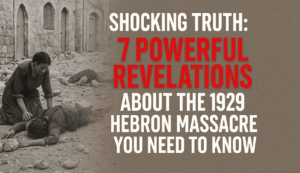Shocking Truth: 7 Powerful Revelations About the 1929 Hebron Massacre You Need to Know
In a compelling conversation, journalist Yardena Schwartz highlights the overlooked alliance between Adolf Hitler and Haj Amin al-Husseini, the Grand Mufti of Jerusalem. Husseini, treated as a high-ranking guest by the Nazis, was deeply involved in their plans and actively worked to prevent Jewish refugees from escaping to Palestine. Schwartz emphasizes the danger of forgetting such critical history, especially within Jewish communities that often focus on resilience rather than the painful roots of conflict. She draws a parallel to how Holocaust survivors were once discouraged from sharing their stories, yet today, that memory is central to Jewish identity.
Similarly, she argues, understanding the foundations of the Israeli-Palestinian conflict is essential to breaking its ongoing cycle. Schwartz criticizes leaders who manipulate religion and fear for personal gain, warning that ignorance of the past fuels continued unrest. She urges both Jewish and broader audiences to confront uncomfortable truths to pave the way toward peace. The conversation ends with a call to balance remembrance with resilience—honoring the past while learning from it.

Shocking Truth: 7 Powerful Revelations About the 1929 Hebron Massacre You Need to Know
The October 7, 2023, Hamas attack on Israel, known as Operation Al Aqsa, marked the deadliest day for Jews since the Holocaust. For journalist Yardena Schwartz, this tragedy mirrored a nearly forgotten event: the 1929 Hebron Massacre. While writing Ghosts of a Holy War: The 1929 Massacre in Palestine That Ignited the Arab-Israeli Conflict, Schwartz uncovered striking parallels between past and present—particularly how false claims about Jewish threats to holy sites fueled both atrocities.
Unearthing the Past
Schwartz first visited Hebron in 2011 but heard nothing of the 1929 massacre until a tip from her mentor, Yossi Klein Halevi, led her to letters written by David Schoenbrun, a young American killed in the violence. Schoenbrun’s vivid accounts of pre-massacre life in Hebron—where Jews and Arabs coexisted peacefully—contrasted sharply with the brutality that followed.
The 1929 Massacre
On August 24, 1929, during the Jewish Sabbath, Muslim mobs stormed Jewish homes in Hebron, slaughtering 67 men, women, and children. The violence, incited by religious leaders like Grand Mufti Haj Amin al-Husseini, stemmed from fabricated rumors that Jews planned to seize the Al Aqsa Mosque and the Ibrahimi Mosque (Tomb of the Patriarchs). Even Sephardic Jews, long integrated into Arab society, were not spared. Families were massacred in their homes, infants killed in their mothers’ arms, and women assaulted. The massacre ended centuries of Jewish presence in Hebron and deepened divisions in the region.
Echoes in Modern Conflict
Schwartz notes that Hamas’s 2023 attack revived the same false narrative: that Jews threatened Al Aqsa. This tactic, she explains, has repeatedly justified violence. Her research reveals how misinformation—spread through mosques, newspapers, and flyers in 1929—prefigured today’s propaganda. Despite warnings, Hebron’s Jewish leaders had refused protection, trusting their Arab neighbors. Tragically, that trust was betrayed.
Global Reactions and British Failures
The 1929 massacre sparked global outrage. Protests erupted in New York, Poland, and the UK, while the U.S. government condemned Britain’s failure to protect Jewish residents. A British inquiry produced a 400-page report but blamed Jewish immigration and prayers at the Western Wall rather than addressing the Mufti’s incitement. The British imposed restrictions on Jewish land purchases—legally acquired from Arab sellers—instead of punishing perpetrators.
The Mufti’s Legacy
Haj Amin al-Husseini escaped accountability, leveraging fear to consolidate power. After fleeing British attempts to arrest him, he allied with the Nazis in WWII, recruiting Muslim soldiers and blocking Jewish refugees from Palestine. Post-war, he influenced leaders like Yasser Arafat and rejected the 1947 UN partition plan, opting for war. His rhetoric—denying Jewish ties to the land and promoting violence—still fuels conflict today.
Resilience vs. Historical Amnesia
Schwartz highlights a tension between resilience and remembrance. While Jewish communities often focus on rebuilding, she warns that glossing over history perpetuates cycles of violence. For example, Holocaust survivors initially faced stigma in Israel but later became central to education on trauma and survival. Similarly, understanding the 1929 massacre—and figures like Husseini—is crucial to addressing the conflict’s roots.
Confronting the Past
Schwartz’s work underscores how misinformation, corruption, and extremist leadership have shaped the Israeli-Palestinian conflict. By revisiting events like the Hebron Massacre, she urges a deeper reckoning with history. “If we don’t confront the full truth of our past,” she argues, “we can’t break the cycle of violence.”
Ghosts of a Holy War bridges past and present, revealing how fear and lies ignited a century of strife—and why remembering these stories matters more than ever.
You must be logged in to post a comment.